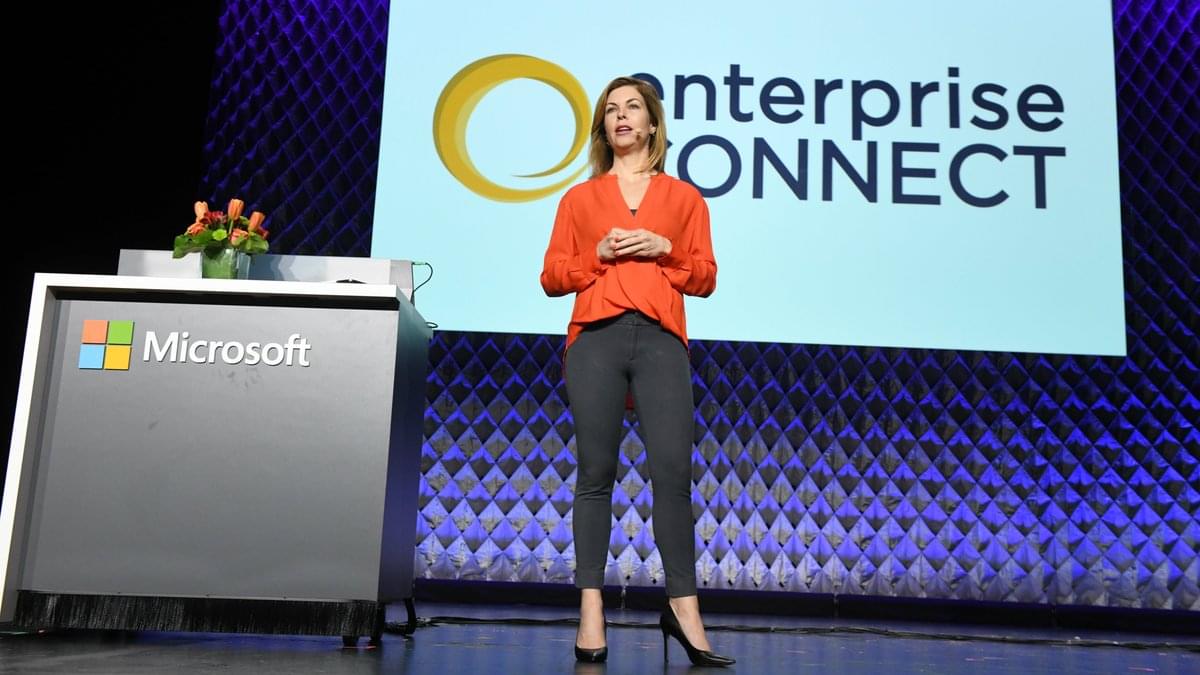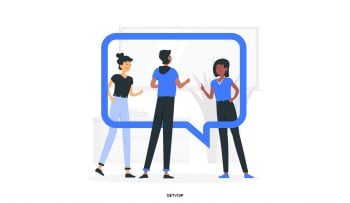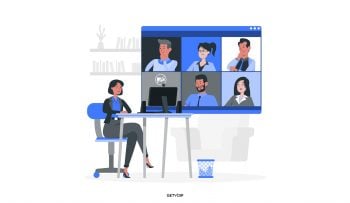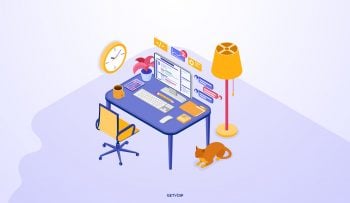Microsoft’s much-anticipated update on Teams here at Enterprise Connect was a bit of a firehose, so there’s quite a lot to digest.
Presented by Lori Wright, GM Microsoft Teams and Skype Marketing, this was a slick production, dense, and fast-paced. With only a half hour to cover a lot of updates, the format was out of necessity, and you need to step back to parse out the important takeaways. There’s a lot to like here, but also some things to wonder about, and I’ll address the essence of these along three thematic lines.
1. Welcome to the intelligent workplace
Humans are intelligent by nature – to varying degrees of course – but with today’s technology, we can now start talking about the workplace along similar lines. We’ve been talking about smart homes, smart cities and smart buildings for years, and team collaboration offerings like Microsoft Teams are showing how the workplace is becoming the next frontier for intelligence. Along with an overly-dramatic video, Lori talked about how AI is creating “an intelligent workplace for everyone” that will break down the barriers that have made collaboration so problematic for so long.
Yes, this is a lofty promise – and one that all the vendors are touting – but the root problems really do need to be addressed. We heard how only 15% of employees feel engaged at work, yet among high-performing companies, that number leaps to 70%. The connection between employee engagement and organizational performance is pretty clear, so the rationale for using AI to create an intelligent workplace is also clear.
That said, technology is the enabler, not the solution to this fundamental challenge. Just because workers adopt Teams, doesn’t mean the workplace will suddenly become intelligent. Teams will make powerful new technologies accessible to workers – true – but there has also been plenty of intelligence in the pre-AI workplace.
This iteration of Teams is not a magic wand that changes everything in a flash. The opening video makes it look easy, and something that will liberate us to be more productive. Technology is no guarantee of working more intelligently – “smart phone” has become somewhat of an oxymoron – and we have to be careful about putting too much blind faith into the possibilities of AI. The vision is certainly exciting, but it’s people who make the workplace intelligent, not the technology.
2. The Microsoft Graph – Big Data for everyone
Microsoft isn’t the only one doing the “graph”, and using AI to connect all the data dots across the ether to make sense of how we do things and how we can then do them better. With 155 million active users per month on Office 365, Lori explained how this produces 6.5 trillion data points. That’s well beyond what humans can manage, but it’s right in AI’s wheelhouse, and this is what the Microsoft Graph is about.
AI harnesses that data to make all forms of information and all sources of data – both inside and outside the enterprise – usable for any worker in the organization. The tools are very powerful and allow us to use data in new ways to solve problems, anticipate potential problems, predict outcomes, make faster decisions, etc. This is consistent with the trend for management to make data-driven decisions, but Microsoft is thinking bigger here, by making these capabilities available to all employees.
A strong message running through Lori’s talk and the video segments was inclusiveness, where data can truly help democratize the workplace. Not only is Microsoft Graph for all ranks – not just executives – but for all types of people. Great examples included hearing-impaired, those with learning disabilities, dyslexia, as well as those who are not native English-speaking. You may not associate social consciousness with giants like Microsoft, but I certainly found that tone to be very progressive.
Full marks for such noble aspirations, but it also reflects how pervasive technology is in our lives, and how public our private lives are becoming. Knowledge management is a bona-fide enterprise challenge, especially given how quickly data is proliferating. That’s a never-ending track, meaning that Big Data will only get bigger, and will only deepen our reliance on AI.
Workers absolutely need better tools for data discovery, capturing that data, processing it, and eventually acting on it. With that comes the danger of interacting even less with each other as these tasks come to demand all of our time. We may also become less inclined to tap our inner curiosity, our instincts, our creativity and our critical thinking. That’s the scenario where the machines are winning, so to speak, at which point it’s hard to go back.
Graph is a great way for Microsoft to ensure that Teams becomes the center of your workday, but not all workers are digital-savvy. Enterprises are often four-generation workplaces, so some will thrive and some will struggle. I think the vision here would be stronger if Teams included some resources or components to help workers stay at the center of things, and ensure that the technology works for them rather than the other way around.
3. Cool features
It would take many posts to break down all the features, and I just want to focus on a few that stand out, especially those that leverage AI to make collaboration more intelligent. Since this was a large-scale product launch, enterprises need to know what’s different now with Teams, especially if still tied to premises-based collaboration tools and/or Skype for Business.
- Real-time translation. Teams now supports 60 languages, and we saw a great example where we watched a woman speaking Chinese on video call, and then hearing it in English. This isn’t really all that new, but real-time translation is constantly improving, and with such broad support for languages, Teams is truly a global platform for collaboration.
- Immersive reader feature. This comes back to inclusiveness, and is a great way to help everyone on the team follow along. For a word you don’t know the meaning of, by mousing over it, a pop-up appears with associated imagery as a visual aid. While perhaps a minor feature of Teams, it reflects a thoughtful approach to making text a more powerful communications mode.
- Meetings are easier now. Hundreds of applications are now supported across the full spectrum of workflows, so there are many more touch points to automate tasks. This applies equally well now to large scale meetings, huddle rooms, remote settings, from mobile devices, etc. One new feature showed how you can start a meeting right from a meeting note in your calendar. The idea is to make the process seamless and intuitive – just a one-click experience, and AI will do the rest. All collaboration vendors are on this path, but Microsoft has a natural advantage by owning the desktop. However, meetings are a well-defined pain point for enterprises, and winning here goes a long way to becoming the platform of choice for all collaboration, as well as the partner of choice for the channel.
- Vertical use cases. We saw a lot of examples for knowledge workers, but time was also spent showing how well Teams supports front line workers. For them, collaboration is a mobile experience, and there were specific applications shown for both healthcare and education sector use cases. One example was an application for floor nurses to manage their shifts, and how managers can use geolocation to validate that team members are where they’re supposed to be. Aside from end-user applications, they illustrated how IT can set configuration policies for specific types of workers, making Teams an end-to-end solution beyond the desktop. I found this to be a strong point for the Teams update, and shows that Microsoft can be relatable beyond knowledge workers and tech-savvy consumers.
- Whiteboard experience. This demo warrants a standalone writeup, but in short, we saw how easy it was to capture content using direct touch on the board, share content and co-create with those not in the room. We also saw how the whiteboard content could be AI-enhanced by blocking out glare and sharpening the writing or images so it’s easier to see for those not in the room. The technology certainly looks impressive, but it’s really not that different from leading offerings like Cisco Webex or Google Jamboard, so I don’t see this giving them any competitive advantage. Consequently, due to their striking similarities, we recently compared Microsoft Teams and Webex in this head-to-head: Microsoft Teams vs. Webex Teams.
There were many other interesting features and updates from the session, but this should provide a good sense of what Microsoft is doing now with Teams. They’re certainly walking the walk, having transitioned 180,000 employees from Skype for Business to Teams. As such, not only do they have great updates to share, but they know how to make the transition to Teams easier and faster than before.
With all the collaboration vendors getting religious now about AI, Microsoft has to get this right, and based on what we saw at Enterprise Connect, it looks like Teams is on the right track. Of course, nothing is a sure thing with tech, and my main caveat here is that they might be setting AI hopes too high. If the workplace doesn’t become more “intelligent”, or if the Graph is just information overkill, enterprises could just as well revert to using Microsoft on the desktop and leave the heavy lifting around collaboration to those with a more proven portfolio.








